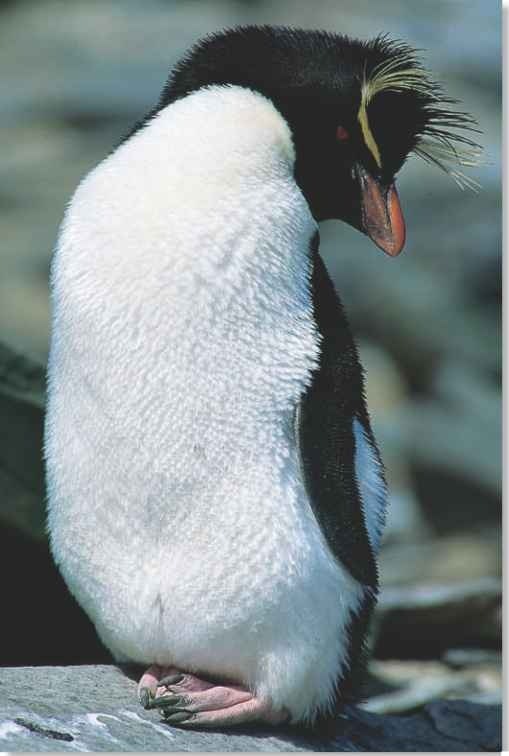ORDER
Sphenisciformes
FAMILY
Spheniscidae
GENUS & SPECIES
KEY FEATURES
• Streamlined for I swimming, it dives 300′ | or more beneath the j surface to catch krill ! ( shrimp) and squid
• Its dense coat of feathers can be flattened to form a watertight barrier against freezing Antarctic waters
• Colonies of thousands assemble to raise their young on remote oceanic islands
WHERE IN THE WORLD?
Lives in oceans near Antarctica; comes ashore on islands in the South Pacific and South Atlantic, including Falklands and Tristan da Cunha
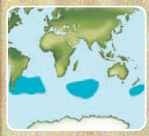
Lifecycle
Perfectly adapted to life in freezing waters, the rockhopper penguin is also mobile on land, hopping over rocky ground to reach breeding sites far from the shore.
Habitat
The hardy rockhopper penguin spends most of its life in the open sea and inshore waters surrounding Antarctica. Its distribution is determined by shifts in the Antarctic Convergence — a boundary that marks the meeting place between bitterly cold, but productive, polar waters and more temperate northerly waters.
The rockhopper comes ashore to breed and molt on rocky islands, preferring steep ground near vegetation.
Natural shelter Rocky outcrops and cliffs offer relief from the wind.
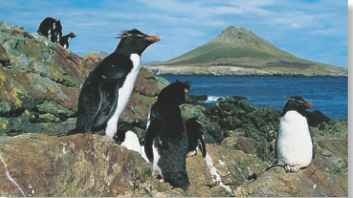
Behavior
From May to October, the rockhopper penguin is at sea, usually several hundred miles from its habitual nesting site. It feeds in flocks that may contain between 10-150 individuals. In shallow, inshore waters where predators such as the killer whale hunt, the penguin maximizes speed by porpoising — swimming at top speed under water, interspersed with brief leaps out of the water to breathe.
Between October and November, the bird is at its crowded nesting site. Once its young are fledged, it goes to sea for 1-2 months before returning to land to molt. When renewing its plumage, the rockhopper must remain on land: for a month it is unable to feed, and may lose almost half of its bodyweight.
Food & hunting

The rockhopper eats krill (shrimp) and other crustaceans, squid and fish. It makes dives that may exceed 300′. When the penguin finds a shoal of fish or swarm of crustaceans, it uses its high speed to chase down a meal.
Relying on sunlight to illuminate prey, the rock-hopper feeds during daylight hours; its deepest dives are made around midday. The male penguin is slightly larger and heavier than his mate; this enables each sex to feed on a different stock of prey, reducing direct competition.
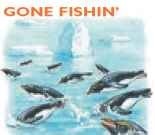
Gathering the gang…
Porpoising along at speeds over 5 mph, a group of penguins heads for a-favorite feeding ground.
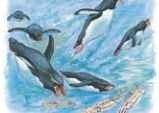
Today’s special…
Shoaling squid come into view; a penguin accelerates sharply and lunges out with its bill agape.
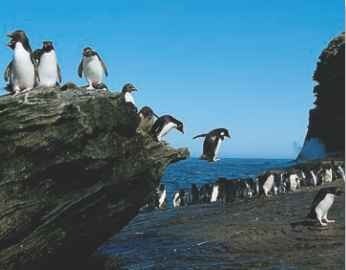
Rockhoffing
Rugged terrain requires a deft, feet-together hop.
Aquatic flier A streamlined body and good underwater vision enable the rockhopper to prey on a variety of fish.
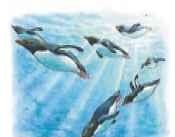
Long descent…
Two penguins embark on a dive, using flippers and feet to force their bodies down.
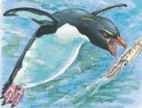
Tucking in
The penguin gulps down small prey, but brings larger items to the surface to subdue them.
Rockhoppers were once the center of a major oil industry on the Falkland Islands. In the late 1800s, millions of birds were boiled to render their bodyfat for oil extraction.
Residents of remote Tristan da Cunha eat about 146 rockhopper eggs per person per year.
Breeding

A Southern exposure In such a barren land, the nest is a basic structure.
The rockhopper penguin breeds in colonies containing hundreds of thousands of pairs. The courting male swings and bobs his plumed head. Each pair defends its nest site with determination, engaging in bill jousts with neighbors. Mating pairs are usually faithful, and many return to the same nest site year after year.
The female lays two eggs, which the parents take turns incubating: one guards the nest while the other feeds the family. Once hatched, all the chicks huddle closely together for-warmth — and for security against gulls and skuas.
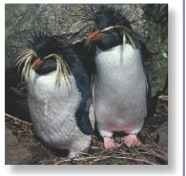
United we stand… Mating pairs fend off both penguins and predators.

conservation
The population on Campbell Island has fallen by 95% since the 1940s, due to a change in sea temperature. Rockhoppers are also threatened by fishing of krill, and in some places by egg-collecting. But there are still some 3 million pairs; the species is not in great danger.
Profile
Rockhopper Penguin
Specially adapted circulation in its exposed feet and individually muscled feathers enable the rockhopper penguin to thrive close to the South Pole.
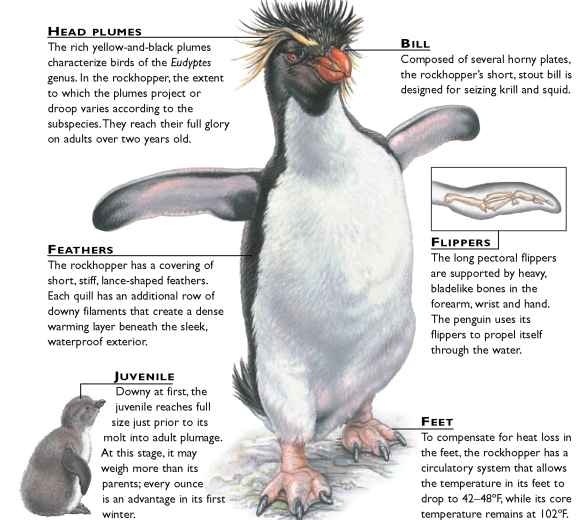
creature comparisons
The rockhopper shares part of its ocean habitat with the chinstrap penguin (Pygoscelis antarctica). Slightly larger than the rockhopper, the chinstrap has an almost identical shape and physiology. It lacks yellow-crested plumes, but has white markings on its chin, throat and cheeks.
Chinstrap
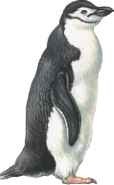
The chinstrap has a more southerly distribution than the rockhopper, nesting on mainland Antarctica, more northerly islands and the tip of South America. It gathers in huge breeding colonies and dives among areas of light pack ice for crustaceans and fish.
Rockhopper

| VITAL STATISTICS Weight 4-11 lbs. maximum weight attained prior to molting |
|
| Length | 22-25″ |
| Sexual Maturity | 4 years |
| Breeding Season | Mainly November-March |
| Number of Eggs | 2, although only 1 usually survives |
| Incubation Period | 28-38 days |
| Fledging Period | About 70 days |
| Breeding Interval | 1 year |
| Typical Diet | Crustaceans and fish |
| Lifespan | 10-15 years |
RELATED SPECIES
• The rockhopper penguin is part of genus Eudyptes, a group of 6 species with golden head plumes. The penguin family, Spheniscidae, contains 17 species in 6 genera. The gentoo penguin, Pygoscelis papua (below), shares its range with the rockhopper.

